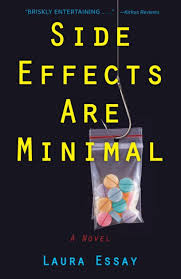Crime has always been a compelling subject for readers and writers alike. The dark allure of real-life criminal activity, combined with the creativity of fiction, has given rise to a genre that both thrills and educates. Blurring the lines between fact and fiction allows authors to explore the human psyche, societal issues, and moral dilemmas in a way that pure nonfiction might not. My novel, Side Effects Are Minimal, is a testament to this blend, drawing inspiration from the harrowing realities of the opioid crisis.
Real crime stories remind us that the most disturbing and thrilling events can—and do—happen in real life. The visceral impact of these true stories creates a solid foundation for fiction. Authors can take the basic framework of actual events and build upon it, adding layers of emotional depth, character development, and narrative twists that might not be present in the factual accounts. Real crimes are often multifaceted, involving a range of motives, consequences, and personalities. This complexity provides rich material for unique characters and plot construction. By delving into the nuances of actual cases, authors can create stories that are not only thrilling but also deeply insightful.
The nightly news, newspaper articles, online news sites, and witnessing the issue firsthand grabbed my attention and continued to poke at me. I had to ask myself, “How big is this? How did it start? Is it just the cartel we see on TV? How many people are affected? Who are they?” I needed answers to these questions. As I discovered the truth, I felt like a child who had found a dark secret and needed to expose it. Claire Hewitt, the protagonist in my novel, is a younger version of me or a wishful image of me. I was an assistant attorney general for the state of Nebraska and know how to fight for what is right, expose the wrongs committed, and get to the truth. Claire embodies the qualities of a determined and compassionate lawyer who fights for the underdog while reconciling her past and never losing sight of herself. Claire’s character is intensely personal; through her, I could channel my experiences and aspirations into a narrative that resonates with readers.
Researching this novel was akin to falling down a rabbit hole. Each news report led to another story, which referenced another until I confronted an epidemic far more extensive than ever revealed. It is sneaky, powerful, and destructive, tearing apart families across the United States. The deceptive power of opioids was a revelation that both shocked and disheartened me. What begins as an innocent and trusting relationship between a physician and patient can become an overnight devastation. Most of society thinks of drug addicts as different from themselves. We believe it’s an us-and-them game. But it’s not. Addiction is standing outside our front doors, waiting for the right moment to bust inside. Under the right circumstances and a stroke of bad luck, any of us could be the next addict.
One of the most startling discoveries was the statistic from the National Institute on Drug Abuse: about 80% of people who use heroin first misused prescription opioids. This statistic alone underscores the pervasive reach of the opioid crisis. The more I read, the more I realized the extent of the epidemic and the insidious ways it affects individuals and families. In Side Effects Are Minimal, the real-life opioid crisis forms the backbone of the story, providing context and urgency. The fictional elements—characters, dialogues, and specific plot points—are crafted to enhance the emotional and psychological impact of the story. This approach not only helps to make the novel engaging but also educates readers about the realities of the crisis. Fiction has the unique ability to humanize statistics, turning abstract numbers into relatable and compelling narratives. By incorporating actual events and data into a fictional framework, authors can shed light on important issues in a way that resonates deeply with readers.
Real crime stories provide a rich tapestry for novelists to explore. They offer a glimpse into the darker aspects of human nature and society while providing entertaining and thought-provoking storytelling opportunities. For crime fiction readers, the appeal lies in the relatability of these stories.
Knowing that the novel is based on actual events adds a layer of intrigue and gravitas. It reminds us that truth can be stranger than fiction and that the most compelling stories are often those rooted in reality. In writing my novel, I aimed to strike this balance, crafting a story that is both a legal thriller and a poignant exploration of the opioid crisis. Through the character of Claire Hewitt, the deceptive assurances of titles, and the rigorous research process, I sought to bring the real-world impact of this epidemic to the forefront, urging readers to look beyond the headlines and see the human faces behind the statistics.
As I continue my writing journey, I remain committed to blending fact with fiction to explore pressing societal issues. My upcoming projects delve into different themes but maintain the same commitment to authenticity and depth. By shedding light on the real stories behind the fiction, I hope to foster greater understanding and empathy, encouraging readers to engage with the world around them in meaningful ways. In the end, the power of storytelling lies in its ability to connect us to the broader human experience, to illuminate the truths hidden in the shadows, and to inspire change. Through the lens of crime fiction, we can explore the complexities of our world, challenge our perceptions, and find a path to a more just and compassionate society.
***


















